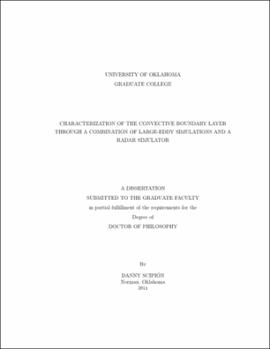| dc.contributor.advisor | Chilson, Phillip||Palmer, Robert | |
| dc.creator | Scipión, Danny Eddy | |
| dc.date.accessioned | 2019-04-27T21:30:58Z | |
| dc.date.available | 2019-04-27T21:30:58Z | |
| dc.date.issued | 2011 | |
| dc.identifier | 99260130402042 | |
| dc.identifier.uri | https://hdl.handle.net/11244/318883 | |
| dc.description.abstract | The boundary layer (BL) is the lowest part of the atmosphere where the flow field is directly influenced by interactions among air, heat, and the Earth's surface. The structure of flow in the BL is dynamic due to the fact that the atmospheric flow is turbulent. Turbulence in the daytime convective boundary layer (CBL) is primarily caused by buoyancy forced from the heated underlying surface. Wind profilers are one of the many instruments used to study and characterize the atmosphere. In addition to in-situ observations, numerical large-eddy simulations (LES) have been probed to adequately reproduce the CBL under different conditions. The focus of this work is to bring the advantages of LES techniques to assist in the interpretation of data from wind profilers. | |
| dc.description.abstract | The present study focuses on an example of flow structure of the CBL as observed in the U.S. Southern Great Plains Atmospheric Radiation Measurement Climate Research Facility in Lamont, Oklahoma on June 8, 2007. The considered CBL flow has been reproduced using LES, sampled with a LES-based virtual boundary layer radar (BLR), and probed with an actual operational wind profiler. The LES-generated CBL flow data are then ingested by the virtual BLR and treated as a proxy for prevailing atmospheric conditions. The virtual BLR has been used to simulate radar signals obtained from wind profilers through the synthesis of Doppler beam swinging (DBS) and spaced antenna (SA) techniques and to retrieve the three-dimensional wind fields. Comparisons of the estimates of the structure parameter of refractive index Cn2, wind fields, vertical velocity variance, and vertical velocity skewness have been presented for the LES, virtual BLR, and actual radar. | |
| dc.description.abstract | It has been observed that during the presence of strong horizontal shear of vertical velocity, the estimates of the horizontal wind fields are biased. This study will quantify the effect of this shear for both wind estimation techniques under different conditions. Additionally, it has been noticed that this shear also biases the estimates of turbulence kinetic energy (TKE) calculated from the variances of the wind fields. Finally, the TKE (eddy) dissipation rate &epsilon can be obtained from radar estimates of Doppler spectral width. Values of &epsilon are obtained from the different oblique and vertical beams and contrasted with the LES estimates obtained through a parameterized expression that relates the dissipation rate to sub-grid TKE and turbulence length scale. | |
| dc.format.extent | 156 pages | |
| dc.format.medium | application.pdf | |
| dc.language | en_US | |
| dc.relation.requires | Adobe Acrobat Reader | |
| dc.subject | Boundary layer (Meteorology) | |
| dc.subject | Eddies--Simulation | |
| dc.subject | Eddies--Mathematical models | |
| dc.subject | Atmospheric circulation--Computer simulation | |
| dc.title | Characterization of the convective boundary layer through a combination of large-eddy simulations and a radar simulator | |
| dc.type | text | |
| dc.type | document | |
| dc.thesis.degree | Ph.D. | |
| ou.group | College of Engineering::School of Electrical and Computer Engineering | |
